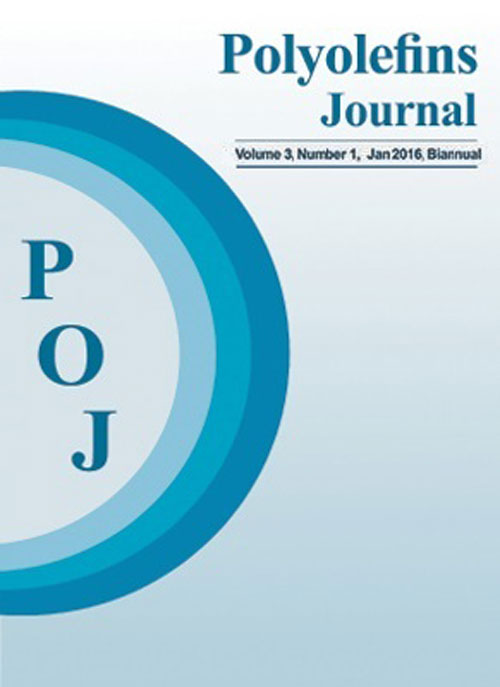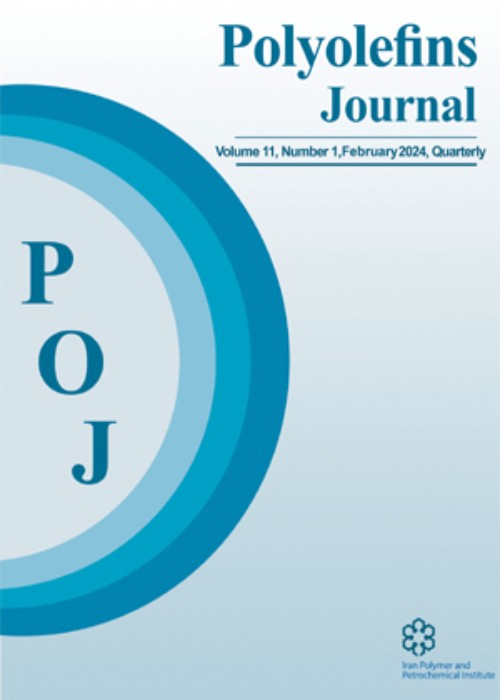فهرست مطالب

Polyolefins Journal
Volume:3 Issue: 2, Spring 2016
- تاریخ انتشار: 1395/04/11
- تعداد عناوین: 6
-
-
Pages 69-77A novel mixing approach for achieving a good dispersion of multi-walled carbon nanotubes (MWCNTs) in ethylene- propylene diene monomer (EPDM) matrix has been investigated. In this approach EPDM was modified with vinyltrimethoxysilane (VTMS) during melt mixing. In addition the effect of MWCNT concentration on mechanical and rheological properties of modified EPDM has been studied. The formulated composites by this method exhibited significantly enhanced physical properties even at very low nanotube concentration. The grafting reaction was confirmed by Fourier transform infrared spectroscopy (FT-IR) peak at 1070 and 1250 cm-1according to Si-O and Si-C vibration. The state of dispersion of the fillers in the polymer matrix was evaluated through transmission electron microscopy (TEM) and scanning electron microscopy (SEM), In addition surface topology was studied with atomic force microscopy (AFM). The results showed that VTMS-grafted on the EPDM surface improved the dispersion of MWCNTs in the matrix. The rheological characteristics have been studied by rubber process analyzer (RPA). Some properties such as storage modulus (Ǵ) and complex viscosity (η^*) increased with increasing MWCNT content. It was found that at concentration of 2 wt.% MWCNT, the nanocomposites exhibited notably enhanced mechanical properties such as modulus and tensile strength.Keywords: Novel modification approach, EPDM, multi, walled carbon nanotube, rheological characteristic, mechanical properties
-
Pages 79-92Spray dry granulation of clay minerals was studied to obtain clay mineral base support material for metallocene supported olefin polymerization catalysts. The morphology of the granules was strongly influenced by the nature of the clay mineral itself.
Because of swelling characteristics of montmorillonite, its water dispersion was highly viscous even in the low slurry concentration (Keywords: metallocene catalyst, activator, support, clay minaral, spray dry -
Pages 93-101In abiotic degradation the action of light radiation is one of the most important parameters, because polymers undergo degradation due to the action of light (natural or artificial). The aim of this study was to investigate the degradation rate for samples of polypropylene (PP) modified with an organic pro-degradant submitted to ageing in a natural environment and to accelerated ageing test. The degradation behavior of the samples exposed to the ageing processes was evaluated through changes in the degree of crystallinity (Xc ), surface morphology (Scanning Electron Microscopy) and molecular weight. The results indicated that for the modified polypropylene samples natural ageing led to a 42.3% reduction in the molecular weight and the surface morphology showed evidence of erosion. In the accelerated ageing process the UV radiation was stronger, which led to a 94.3% increase in the degree of crystallinity and micro-voids were present on the surface of the modified polypropylene.Keywords: polypropylene, degradation, organic pro, degradant, ultra, violet radiation
-
Pages 103-117A novel imido-modified SiO2-supported Ti/Mg Ziegler-Natta catalyst for ethylene and ethylene/1-hexene polymerization is investigated. The catalyst is prepared by modification of (SiO2/MgO/MgCl2)TiClx Ziegler-Natta catalysts via supporting vanadium species followed by reaction with p-tolyl isocyanate as imido agents, to get the merits from both the SiO2-supported imido vanadium catalyst and the (SiO2/MgO/MgCl2)TiClx Ziegler-Natta catalyst. The effects of cocatalyst amount, hydrogen and dosage of 1-hexene on polymerization behavior and the microstructures of their polymers are systematically investigated. Compared with (SiO2/MgO/MgCl2)TiClx Ziegler-Natta catalysts and vanadium-modified (SiO2/MgO/MgCl2)TiClx Ziegler-Natta catalysts, the imido-modified SiO2-supported Ti/Mg catalysts show lower but more stable activity including homopolymerization, polymerization with hydrogen and copolymerization owing to imido ligands, indicating that p-Tolyl isocyanate was unfavorable to improving catalytic activity but benefited the stability, and the products of all catalysts show lower 1-hexene incorporation but much higher molecular weight (MW) with medium molecular weight distribution (MWD). The most unique feature of the novel catalysts is the excellent hydrogen response without lowering the polymerization activity, showing great potential for industrial application.Keywords: Ziegler_Natta catalyst_imido V compound_ethylene polymerization_polymerization kinetics_copolymerization
-
Pages 119-133Hyphenating High Temperature High Performance Liquid Chromatography (HT-HPLC) with High Temperature Size Exclusion Chromatography (HT-SEC) (High Temperature Two Dimensional Liquid Chromatography (HT-HPLC x HT-SEC or HT 2D-LC)) leads to an isocratic elution in the second dimension, which in turn enables to use IR detector (quantitative detection) for monitoring the eluting polymers. Experimental data obtained from HT 2D-LC with IR detector are usually presented as contour plots, which can be mathematically described in matrices. Quantitative data about chemical composition, molar mass and concentration of all the segments, which are present in a polymer, can be obtained, after calibrating the HPLC separation (HPLC elution volume vs chemical composition), SEC separation (SEC separation vs molar mass) and response of the IR detector (IR response vs mass of the polymer). A new procedure based on subtraction and addition of matrices is described, which enables quantitative comparison of different polymer materials. This procedure enables to determine, which components are present in both materials (i.e., identical components or segments) and which are present only in one from both the materials (i.e., unique segments). Moreover, molar mass distribution, as well as chemical composition distribution of both identical and unique segments is evaluated from experimental data. The procedure was applied on two different ethylene-propylene copolymer samples.Keywords: ethylene, propylene copolymer, high temperature two, dimensional liquid chromatography, quantitative detection, infra, red detection, size exclusion chromatography
-
Pages 135-146Ethylene / 1-butene copolymers at different comonomer levels were synthesized using Ziegler-Natta catalyst to evaluate the applicability of thermal fractionation methods in predicting chemical composition distribution (CCD). The continuous melting endotherms by DSC were converted to continuous CCD, and the average comonomer contents were compared with NMR results. DSC underestimated comonomer content specifically at higher levels and was more sensitive to the drawn baseline. The thermally fractionated melting endotherms by SSA method were deconvoluted and transformed into discrete CCDs. SSA method underestimated average comonomer content even more, however results were more reproducible. The main shortcoming of the thermal methods was the inability of short ethylene sequences in forming discernible lamella thicknesses at high comonomer levels. Calibration curves were created for converting the predicted comonomer contents into absolute values and used for studying industrial LLDPEs with different comonomer levels. It was shown that SSA provides more reliable results and correlates more reasonably to the measured densities.Keywords: chemical composition distribution, lamella thickness, short chain branching, thermal fractionation, Ziegler, Natta catalyst


